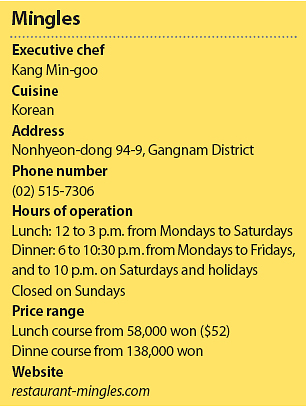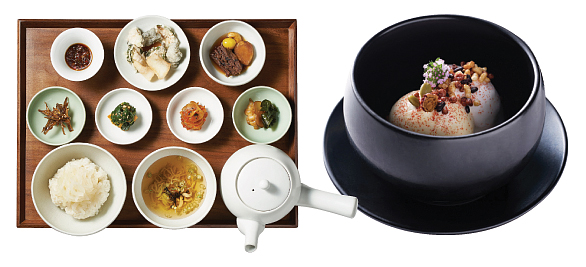At Mingles, a focus on vegetables

Chef Kang Min-goo in the kitchen of his modern Korean restaurant, Mingles, in Gangnam District, southern Seoul. The cap is a signature part of the uniform. [PARK SANG-MOON]
Enter Mingles, a Korean restaurant with a vegan menu. The three-year-old establishment in southern Seoul’s bustling Gangnam District was one of the first to be recognized by global foodies, even making the list of Asia’s 50 Best Restaurants.
Mingles earned its fame for serving Korean food in Western-style courses, but many restaurants have since adopted the concept. So to distinguish himself, executive chef Kang Min-goo has tried to focus on perfecting the basics, specifically his vegetables.

The vegan menu started as a gesture to his friend and teacher Jeong Kwan Sunim, a Buddhist nun at Baekyang Temple who is one of the world’s foremost experts on temple cuisine. He wanted her to taste the food at his restaurant and put together a vegan menu after months of meeting with her and studying her use of vegetables.
The menu has since been updated several times. Those who want to try the vegan course have to make reservations in advance, but diners can enjoy Kang’s meticulously made vegetables on the regular menu, either as amuse-bouche (a garnish for the main course) or as banchan (small side dishes).
To show just how seriously Kang takes his vegetables, Mingles has signed a partnership with a local farm to plant and grow vegetables that are only used at the restaurant.
“Even Koreans have a hard time naming more than five vegetables they often eat, so we try to use a variety,” the chef said. “And to show how the same vegetable and herbs can taste differently, we change the seasoning and cooking methods each season.”

Popular dishes at Mingles include bansang, left, a set meal with rice, soup and side dishes, many of which are vegetables, and the Jang Trio, a dessert made with three different types of fermented sauces including gochujang (red pepper paste). [MINGLES]
“When you take time to make the basic items that are the pillar of your dish hit a certain level of quality, many other new dishes that can be derived from there can also reach a higher level,” Kang said.
No one told Kang that he needed to perfect the foundational essence of his food. If that was the case, he probably wouldn’t have succeeded. It was the personal investment he made to the craft - researching cooking methods in his spare time while running his restaurant - that produced results.
“I never called my food ‘modern Korean,’ but that’s how guests at the restaurant saw it,” Kang said. He was initially worried that such a label would limit the kind of food he could make. “After running the restaurant for three years though, my desire to study more has become even bigger, and I have become comfortable with saying that what I do is ‘my way’ of making Korean food, and I’m confident that the way I do things will take me in the direction I want to go.”
Kang started getting international attention just a year after he opened the restaurant, and he was increasingly feeling the pressure. He didn’t want to be the chef representing Korean cuisine and was wary of his restaurant dictating to an international audience what Korean food was. In 2016, three Korean restaurants landed on Asia’s 50 Best list, and Mingles was ranked the highest, though it was the least well known. Jung Sik Dang was already popular, with a location in New York that had two Michelin stars, and the other, La Yeon, was a hotel restaurant.
Then the Michelin Guide came to Seoul, and the list of Korean restaurants known to the world suddenly expanded. “With other restaurants also on the map, I feel a lot of relief,” Kang said, “and now I can do more studying to serve my style of food.”
Kang is traveling abroad a lot to expand his skill set, even as aspiring chefs are lining up to work in his kitchen and learn from him. Early this year, he studied at Flocon de Sel in Megeve, France, and Relae in Copenhagen. “Learning what’s practical and technical in other places is key for me, as no study is better than just being in the kitchen and getting your hands dirty while observing how others do it,” Kang said.
“Famous chefs who lead trends after running their restaurants for a couple of decades bring their idea from their diverse experiences, and I like being next to them in person and learning directly from them, since I and my restaurant are still young, and there is still so much for me to take in.”
BY LEE SUN-MIN [summerlee@joongang.co.kr]










with the Korea JoongAng Daily
To write comments, please log in to one of the accounts.
Standards Board Policy (0/250자)